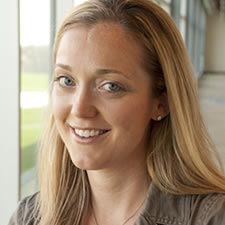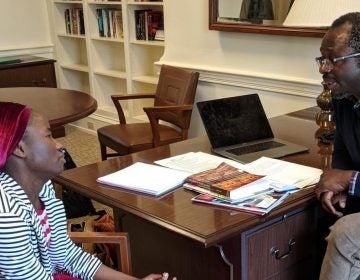Lawsuit brewing over refugee education in Lancaster
Listen 4:46
In this file image, teacher Laura Kangay, center, helps a student with his reading at Lincoln Middle School in Lancaster, Pa. (AP File Photo/Alex Brandon)
Older student refugees are slipping through the cracks — in part, some allege, because schools are breaking the law.
About 17,000 school-aged refugees move to the U.S. in an average year, an estimate that’s a few years old and likely growing along with overall resettlement activity.
But no one is tracking how young refugees fare in school here.
Georgetown University released a study earlier this year looking at education access by students with limited English proficiency.
It focused on undocumented immigrants.
But researcher Zenandeh Booi says some trends apply to refugees; specifically, schools discouraging or denying enrollment, particularly to older children, and failing to provide translation when communicating with families.
“It could be, in some cases, a lack of resources to adequately accommodate these kids. And in some other instances, it’s, essentially, they don’t want these kids in their schools,” Booi says. “So, to a large extent, districts are dealing with a lot in trying to accommodate these kids. But at the same time, it can’t be used for a reason why you completely exclude a child from being able to access education.”
Actually, federal law prohibits it. But it’s happening anyway, as documented by the Georgetown study and lawsuits in multiple states.
Several school districts in New York settled related lawsuits this spring, just before another was filed in Florida.
And one Pennsylvania district looks like it’s next.
The ACLU of Pennsylvania’s researching a lawsuit against the public school district in the city of Lancaster, long known as a hub for refugee resettlement.
“The school district seems to have a good program for English Language Learners at McCaskey High School and that program seems to be completely off limits to the students in Phoenix [Academy]. That not only makes no sense, but we’re investigating whether or not that’s illegal,” says Vic Walczak, legal director for the organization.
Lancaster lawsuit
Walczak says he’s representing six student refugees against the School District of Lancaster and believes about 30 are enrolled at Phoenix Academy, an alternative school described as an accelerated credit program for students at risk for not graduating on time.
The problem might go beyond refugees, Walczak says, affecting other students who are between the ages of 17 and 21, lack English skills or both. But it was a refugee caseworker who first alerted him after observing some patterns:
The district is accused of turning away student refugees in their late teens, delaying enrollment by weeks or months rather than the five days allotted by state law, or automatically sending them to Phoenix, even though students are supposed to go through a process — including a hearing with parents — before they go to Phoenix.
And, maybe, it’s linked to pressure to keep up graduation rates.
Superintendent Damaris Rau, who says she’s aware of the potential lawsuit, addressed the caseworker’s claims.
Rau says the same English language instruction’s available at Phoenix as Lancaster’s McCaskey High School.
As for the rest?
“We’ve really looked at our policies,” says Rau, who’s a year into her job. “We’re doing everything we need to be doing according to the law.
Causes and solutions?
Public Interest Law Center lawyer Michael Churchill has handled similar cases, including an active one against Philadelphia schools for failing to translate individualized education plan documents for special education students and their families.
Churchill says the law, and its ambiguity, are partly to blame.
Federal law, essentially, requires schools to “make meaningful efforts to provide equal educational opportunities, including translation services,” Churchill says.
“But the scope of those requirements, I think it is fair to say, are much less clear,” he says.
The particulars are, largely, left to states.
Pennsylvania Department of Education officials say schools have to take steps to support students based on their needs and district resources. PDE provides more detailed information, like how many hours of English language instruction students should get. But they’re guidelines based on best practices — not requirements, PDE officials say.
Then there’s funding.
Federal School Impact Grants are meant to defray the cost of refugee education. In Pennsylvania, they’re administered by the state Office of Refugee Resettlement, headed by Charlotte Fry.
“It’s never a lot and we do our best to distribute that money across the state to cities that are heavily impacted by refugees. And, so, the grants are very equally divided to all the recipients, they’re $75,000 each. Lancaster has two,” Fry says.
So, an amount of money that would barely cover hiring two teachers, to pay for needs specific to hundreds of refugee students and their families.
Lancaster fills in gaps by partnering with outside organizations.
Burrowes Elementary School and Eastern Mennonite University, for example, run a summer session for ELL students in first through sixth grades, which is free to the district and provides EMU students with requisite hours in the field.
And there’s the community center that opened about a year ago at Reynolds Middle School. The center offers a health clinic, tutoring and translation, and serves as a dissemination point for donated clothes and school supplies for families that can’t afford to buy them.
These and other programs are considered models. But they tend to focus on younger children.
Some older students seem to be slipping through the cracks.
Keep in mind, too, that the violence and instability that forced refugees from their homes and landed them here probably interrupted their formal education or prevented it entirely. The gaps in or lack of schooling, the language barrier, the impoverished status of most families when they first arrive — it’s all compounded by students’ age. The closer they are to the age of 21, the state cutoff for entitlement to a free public education, the harder it becomes to graduate on time in face of these challenges.
Churchill, the lawyer from Philly, says it’s critical to sort this out, court battles aside.
“We all have a stake in making sure that children are educated so they become productive adults,” Churchill says. “And if you don’t do that, if you exclude some because they have language problems or because they have disabilities or what have you, you are — in the long run — increasing the social costs for everyone.”
Editor’s note: This post has been updated to update the number of student refugees.
WHYY is your source for fact-based, in-depth journalism and information. As a nonprofit organization, we rely on financial support from readers like you. Please give today.





